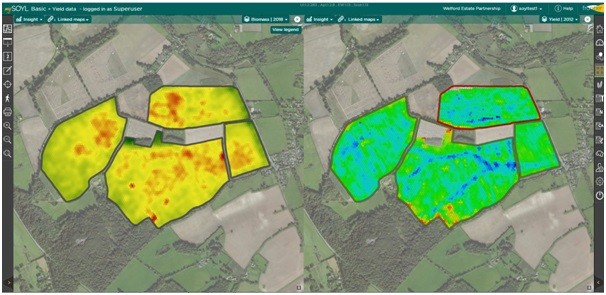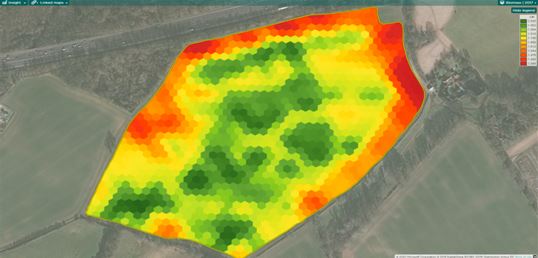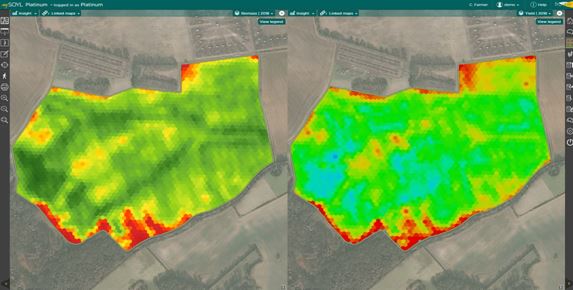Are you making the most of biomass imagery?
Unlike some of the advances in precision farming, biomass imagery doesn't require specialist or expensive equipment. In fact all that's really needed is a computer and a desire to discover some information that could be of value to your farm business.
Surprisingly, however, there are a number of farmers who are not fully utilising biomass imagery and its benefits – but why the reluctance?
It's not just about variable rate nitrogen
Often when I speak to growers there is a misconception that biomass imagery is only useful to those who are carrying out variable rate nitrogen applications.
While it's true that one of the main uses of the technology is to help ensure an even crop and efficient use of fertiliser, there are an array of other ways it can benefit your business too. Last year, SOYL Regional Business Development Manager, Stuart Alexander, wrote a great blog about some of the ways that satellite imagery can contribute to the management of your farm and in truth, the list is endless! To build on Stuart's advice, I've put together some more information below which helps to highlight the value that this technology can bring.
You can use biomass imagery to...
- Apply variable rate plant growth regulators (PGRs)
Many growers are now seeing the benefits of using biomass imagery to apply PGRs. When you consider the importance of canopy management in crops such as winter oilseed rape, applying your PGRs variably to ensure that forward areas are held back slightly so that any backward crops can catch up becomes increasingly important. This is particularly true for seasons such as that we are in now, where variation is likely due to the challenging weather conditions experienced during crop establishment. This in turn, brings me to my next point...
- Establish your crops
Before you have even hooked the drill up to the tractor, you can use previous years' biomass imagery to fine-tune your seed rates. If you notice past areas of low biomass, you can potentially counteract these in the current year by increasing the seed rate in those locations.
Conversely, high biomass areas – particularly those with a history of lodging – can be targeted with a reduction in seed rates.
- Manage workload
With biomass imagery, by viewing average values you can easily identify any priority fields where nitrogen or crop protection products need to be applied first. Even before the application season begins, by keeping track of your crops you can identify areas that might be thinning out and therefore need closer inspection.
In fact, many agronomists I talk to are making use of biomass imagery to help them prioritise their crop walks, ensuring they address any potential issues at the earliest opportunity.
- Help with grass management
While much of the focus on biomass imagery has been centred on the arable sector, it can also add value to those working with livestock.
For example, by assessing the available grass biomass in each field, biomass imagery can help with the movement of livestock onto and out of the appropriate fields at the correct time. It can even be taken a step further – by converting the Normalised Difference Vegetation Index (NDVI) into dry matter, farmers can use the technology to create a grass feed wedge for the farm.
- Predict yield and crop performance
Although yield mapping is becoming more commonplace, it is still not available to every grower due to the associated costs. However, biomass imagery is readily available to everyone and can still offer some valuable insight.
By assessing your biomass you can start to predict any variation in your potential yields come harvest, while also identifying any higher yielding areas. The above image shows just how closely a late season biomass image can correlate to a yield map, providing a valuable tool for those without a yield mapping enabled combine.
- Help with novel queries
As well as the above, some farmers are really putting biomass imagery to the test and finding that it can help with some very specific queries.
One customer I know of actually used it to quantify crop damage caused by his neighbour's cattle breaking into a field. In a similar vein, another grower used the technology to compare an existing crop with that recorded in previous years, allowing him to make a claim for crop loss as a result of ongoing utility works on a nearby farm.
Use the technology to meet the needs of your business
The examples above are a great mix of some of the things that biomass imagery can help with, but they are by no means exhaustive. There is a lot to be gleaned from the biomass imagery of your farm and you really can make the data work for you, helping you to meet the goals most important to your business.
It's easy to view biomass imagery from within MySOYL, our precision farming application, available within Frontier's free online farm management platform, MyFarm.
For help and guidance on how to get started, please speak to your local SOYL contact or get in touch with us today.
As a subscriber, you’ll receive email alerts each time a new blog is published so you can always stay updated with the latest advice and insights from our experts








Comments